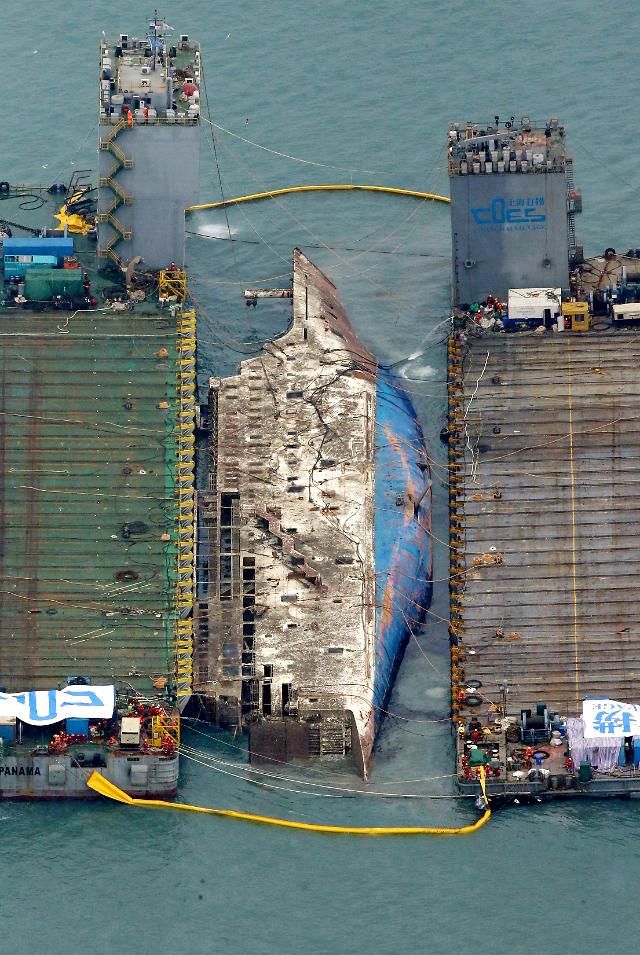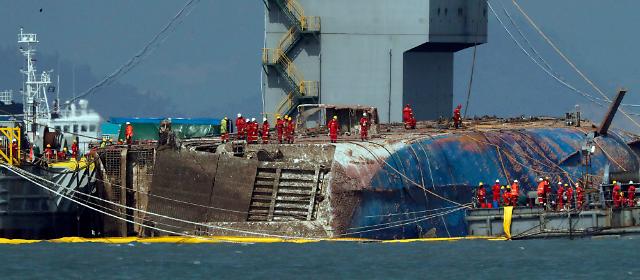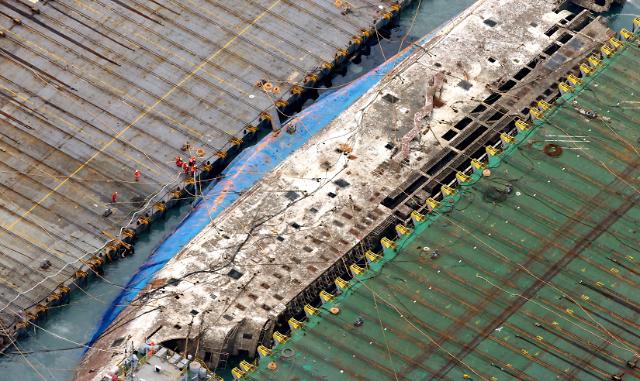
[Yonhap Photo]
Chinese salvage workers stepped up their work to lift a passenger ferry above the water, three years after it sank with the loss of more than 300 lives, most of them schoolchildren in a disaster that revealed inefficiency in South Korea's safety control system.
The operation has been on and off due to strong currents that swayed hauling lines used to raise the ferry between the two barges. Salvage workers managed to raise it about 8.5 meters above the sea surface as of 5:00 pm (0800 GMT), government officials.
TV footages and pictures showed salvage workers standing on the corroded vessel.
"If things go smoothly, I believe the Sewol is expected to reach Mokpo on April 4 or the next day," Minister of Oceans and Fisheries Kim Young-suk.
Relatives of the nine victims who remained unaccounted for have watched the operation aboard a boat in nearby waters. The nine included four students, two teachers and a family of three people -- a seven-year-old boy, his father and mother.

[Yonhap Photo]
Government officials have been cautious in lifting the Sewol ferry which sank in waters off the southwestern island of Jindo on April 16, 2014. About 20 support vessels, backed by two helicopters, are on standby, along with a semisubmersible ship that will carry the ferry to the southwestern port of Mokpo.
The overloaded Sewol was carrying 476 people, including 325 students from a high school in Ansan, when it sank. Only 75 students survived. A total of 295 bodies were recovered. At initial salvage operations, strong currents and muddy waters at the site of the sunken vessel left two divers dead and dozens injured.
The task has been led by China's state-run Shanghai Salvage Co. with a history of receiving good marks for its experience in salvaging sunken vessels. The company used a frame built with metal beams on the sea floor instead of drilling holes into its side and closed all openings to inject air into tanks inside and install large airbags and other devices.
Along with a substantial technical challenge, the operation has been hampered by a tough environment such as strong currents and limited working hours because the Sewol lies 45 meters down on the seabed.

[Yonhap Photo]
At initial salvage operations three years ago, strong currents and muddy waters at the site of the sunken vessel left two South Korean divers dead and dozens injured.
The disaster -- blamed on the ship's illegal redesign and overloading left unchecked by regulators -- prompted calls to overhaul the nation's lax safety standards and tackle deep-rooted corruption.
It has been the subject of debate over the absence of ousted president Park Geun-hye for seven hours. She was impeached by parliament partly for neglecting her duty to supervise a rescue operation during the disaster. Government officials and coastguard authorities were criticized for failing to take quick steps.
Lim Chang - won = cwlim34@ajunews.com




